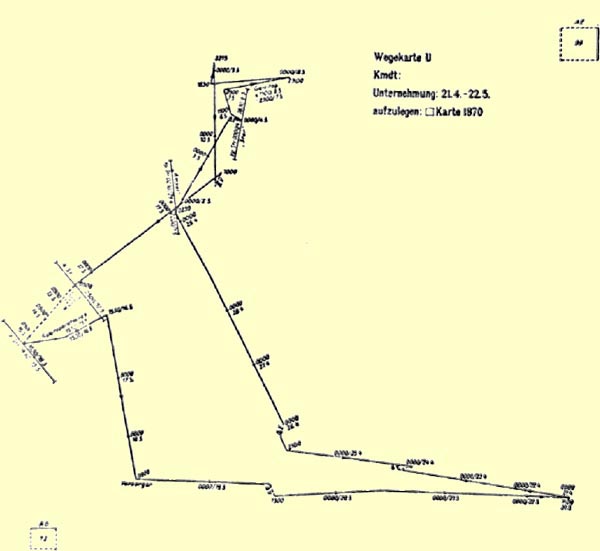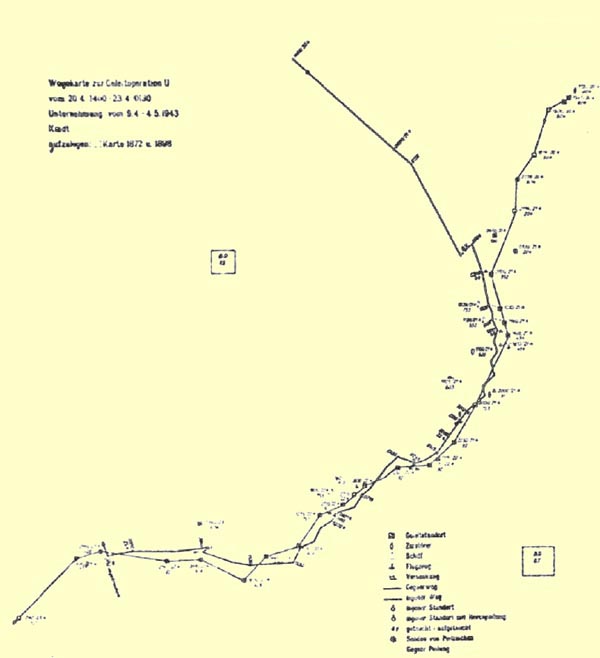Copy No. 126 |
||
24 April 1943. |
||
B.d.U. Standing War Order No. 501 |
||
(New version May 1943) |
||
War Diary Keeping |
||
| The rules for the preparation of war diaries apply in principle, provided this instruction does not indicate otherwise. | ||
| In particular it is ordered: | ||
| 1. The war diaries [Kriegstagebuch (K.T.B.)] of U-boats are to be completed immediately after return from each operation. A new one is then to be started at once, beginning with the lay days in harbor or dock, and carried on continuously up to the conclusion of the next operation. It must afford a sequential review of the activities and positions of the boat. The first K.T.B. must contain a short overview of the time from the commissioning up to departure on the first war patrol in which the date of commissioning, times and places of workups and shipyard work are set forth. A copy this first K.T.B. for the time of the commissioning up to departure on the first war patrol is sent to the responsible front flotilla before departure from the homeland. | ||
| 2. All copies of war diaries are to be signed at the end by the commander himself in the following form: | ||
Onboard, the . . . . |
||
Signature |
||
Rank and Commander |
||
| The note: "Signed" is not permissible, because the war diary is an official document. | ||
| 3. The following are produced and submitted: | ||
| 1st copy care of B.d.U. for O.K.M. | ||
| 2nd copy care of B.d.U. for O.K.M. | ||
| 3rd copy for B.d.U. | ||
| 4th copy for Kmdr.Adm. der U-Boote | ||
| 5th copy for F.d.U.- (West, Italian, Norwegian) | ||
| 6th copy for F.d.U. - Ausbildung | ||
| 7th copy for 27. U-Flottille | ||
| 8th copy remains with the Flotilla. | ||
| The first copies are on the prescribed forms, the remaining copies are produced on copying paper. | ||
| The first, second and third copies of the K.T.B. and the first copy of the K.T.B. engineering section [K.T.B. Abschnitt Maschine] are presented in person by the Commander on the day of the comprehensive oral report to B.d.U. | ||
| 4. The following enclosures are to be produced: | ||
| a) Track chart of the boat, | ||
| b) Track chart of convoy operations, | ||
| c) Attack sketches, | ||
| d) Collation (in clear text) of important Radio Messages for the patrol, separately for Officer Only and General messages. | ||
| Naval Official Instruction No. 97 [e) as required] | ||
| e) As required: minefield reports, minefield sketches, prize reports, reports on special operations, | |||||||||||||||||||||||
| f) Combat shooting data, | |||||||||||||||||||||||
| g) K.T.B. Maschine. | |||||||||||||||||||||||
| Which are attached: | |||||||||||||||||||||||
| 1st copy no enclosures, | |||||||||||||||||||||||
| 2nd and 5th -7th copies attach a, d and e, | |||||||||||||||||||||||
| 3rd and 8th copies attach a-g, | |||||||||||||||||||||||
| 4th copy attach a, d-g | |||||||||||||||||||||||
| Barograph strips for the patrol are attached to the copies of K.T.B.s for F.d.U. West. | |||||||||||||||||||||||
| Flotillas are exempted from limits on copies of the enclosures at their own discretion. | |||||||||||||||||||||||
| For a): The boat's track chart is on tracing paper, marked on Grid Square Chart 1870 G, it must indicate the boat's track outside warning areas or restricted routes. | |||||||||||||||||||||||
| For b): The track chart of convoy operations, one for each convoy which was operated on, is on tracing paper, marked on the large copy of the Grid Square Chart. For the North and Central Atlantic, the following charts are to be used: 1899 G, 1897 G, 1872 G, 1900 G, 1898 G, 1873 G, 1874 G, 1909 G, 1906 G, 1875 G, 1876 G. | |||||||||||||||||||||||
| These track charts must show the track of boat in black, the track of the convoy from contact reports of other boats or own sightings and all intercepted enemy messages in red covering the time from the beginning of own operations (not just from the first own contact) up to the conclusion. | |||||||||||||||||||||||
| On the track chart, the number of the Grid Square Chart on which it is marked, and two reference squares are to be entered. | |||||||||||||||||||||||
| The navigation correction between accepted ship's position and the actual position must be shown. | |||||||||||||||||||||||
| For e): Attack sketches are to be drawn for all attacks on warship formations and convoys. For other attacks only in cases where either the production of a sketch is required for explaining the actions of the Commander, or is of special importance for later war-research study. | |||||||||||||||||||||||
| All enclosures are to be provided with head stamp, diary number, boat number and name of the Commander. | |||||||||||||||||||||||
| 5. The following points are emphasized for the preparation of war diaries: | |||||||||||||||||||||||
|
|||||||||||||||||||||||
[c) Following] |
|||||||||||||||||||||||
|
||||||||||||||||||||||||||||||||||||||||||||||||||||||||||||||||||||||||||
| 6. Attention is drawn to the attached examples in the enclosures. | ||||||||||||||||||||||||||||||||||||||||||||||||||||||||||||||||||||||||||
Enclosure 1 to Standing War Order
No. 501. |
||||||||||||||||||||||||||||||||||||||||||||||||||||||||||||||||||||||||||||||||||||||||||||||||||||||||||||||||||||||||||||||||||||||||||||||||||||||||||||
Example for K.T.B.-
Keeping. |
||||||||||||||||||||||||||||||||||||||||||||||||||||||||||||||||||||||||||||||||||||||||||||||||||||||||||||||||||||||||||||||||||||||||||||||||||||||||||||
(Excerpt of K.T.B.
..U-x..) |
||||||||||||||||||||||||||||||||||||||||||||||||||||||||||||||||||||||||||||||||||||||||||||||||||||||||||||||||||||||||||||||||||||||||||||||||||||||||||||
|
||||||||||||||||||||||||||||||||||||||||||||||||||||||||||||||||||||||||||||||||||||||||||||||||||||||||||||||||||||||||||||||||||||||||||||||||||||||||||||
|
||||||||||||||||||||||||||||||||||||||||||||||||||||||||||||||||||||||||||||||||||||||||||||||||||||||||||||||||||||||||||||||||||||||||||||||||||||||||||||||||||||||||||||||||||||||||||||||||||||||||||||||||||
Enclosure 2 to Standing War Order
No. 501. |
||
 |
||
Enclosure 3 to Standing War Order
No. 501. |
||
 |
||